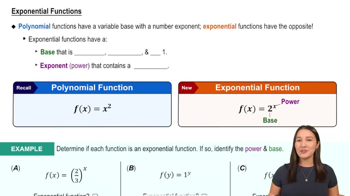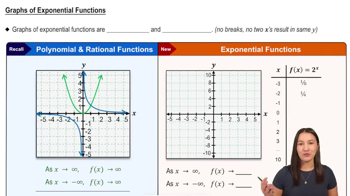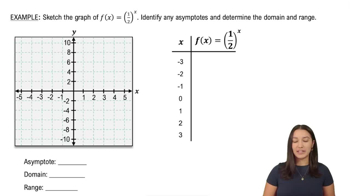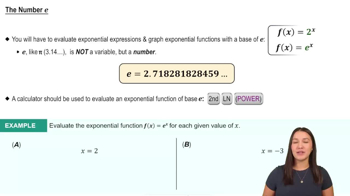Table of contents
- 0. Functions7h 52m
- Introduction to Functions16m
- Piecewise Functions10m
- Properties of Functions9m
- Common Functions1h 8m
- Transformations5m
- Combining Functions27m
- Exponent rules32m
- Exponential Functions28m
- Logarithmic Functions24m
- Properties of Logarithms34m
- Exponential & Logarithmic Equations35m
- Introduction to Trigonometric Functions38m
- Graphs of Trigonometric Functions44m
- Trigonometric Identities47m
- Inverse Trigonometric Functions48m
- 1. Limits and Continuity2h 2m
- 2. Intro to Derivatives1h 33m
- 3. Techniques of Differentiation3h 18m
- 4. Applications of Derivatives2h 38m
- 5. Graphical Applications of Derivatives6h 2m
- 6. Derivatives of Inverse, Exponential, & Logarithmic Functions2h 37m
- 7. Antiderivatives & Indefinite Integrals1h 26m
- 8. Definite Integrals3h 25m
0. Functions
Exponential Functions
Problem 3.9.97b
Textbook Question
97–100. Logistic growth Scientists often use the logistic growth function P(t) = P₀K / P₀+(K−P₀)e^−r₀t to model population growth, where P₀ is the initial population at time t=0, K is the carrying capacity, and r₀ is the base growth rate. The carrying capacity is a theoretical upper bound on the total population that the surrounding environment can support. The figure shows the sigmoid (S-shaped) curve associated with a typical logistic model. <IMAGE>
{Use of Tech} Gone fishing When a reservoir is created by a new dam, 50 fish are introduced into the reservoir, which has an estimated carrying capacity of 8000 fish. A logistic model of the fish population is P(t) = 400,000 / 50+7950e^−0.5t, where t is measured in years.
b. How long does it take for the population to reach 5000 fish? How long does it take for the population to reach 90% of the carrying capacity?
 Verified step by step guidance
Verified step by step guidance1
Identify the logistic growth function given in the problem: P(t) = 400,000 / (50 + 7950e^(-0.5t)).
Set P(t) equal to 5000 to find the time t when the population reaches 5000 fish: 5000 = 400,000 / (50 + 7950e^(-0.5t)).
Multiply both sides by (50 + 7950e^(-0.5t)) to eliminate the fraction: 5000(50 + 7950e^(-0.5t)) = 400,000.
Rearrange the equation to isolate the exponential term: 5000 * 50 + 5000 * 7950e^(-0.5t) = 400,000.
Solve for t by first isolating e^(-0.5t) and then taking the natural logarithm of both sides.
Recommended similar problem, with video answer:
 Verified Solution
Verified SolutionThis video solution was recommended by our tutors as helpful for the problem above
Video duration:
7mPlay a video:
Was this helpful?

 6:13m
6:13mWatch next
Master Exponential Functions with a bite sized video explanation from Callie
Start learning




